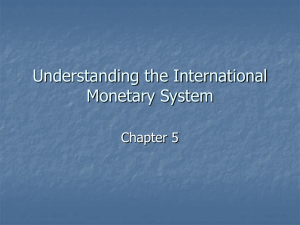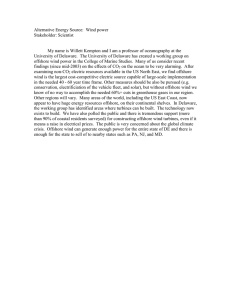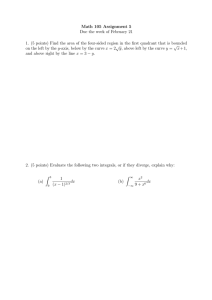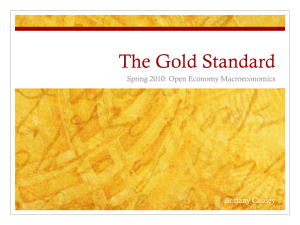Part 1: The Great Swindle of the 21 International Financial System
advertisement
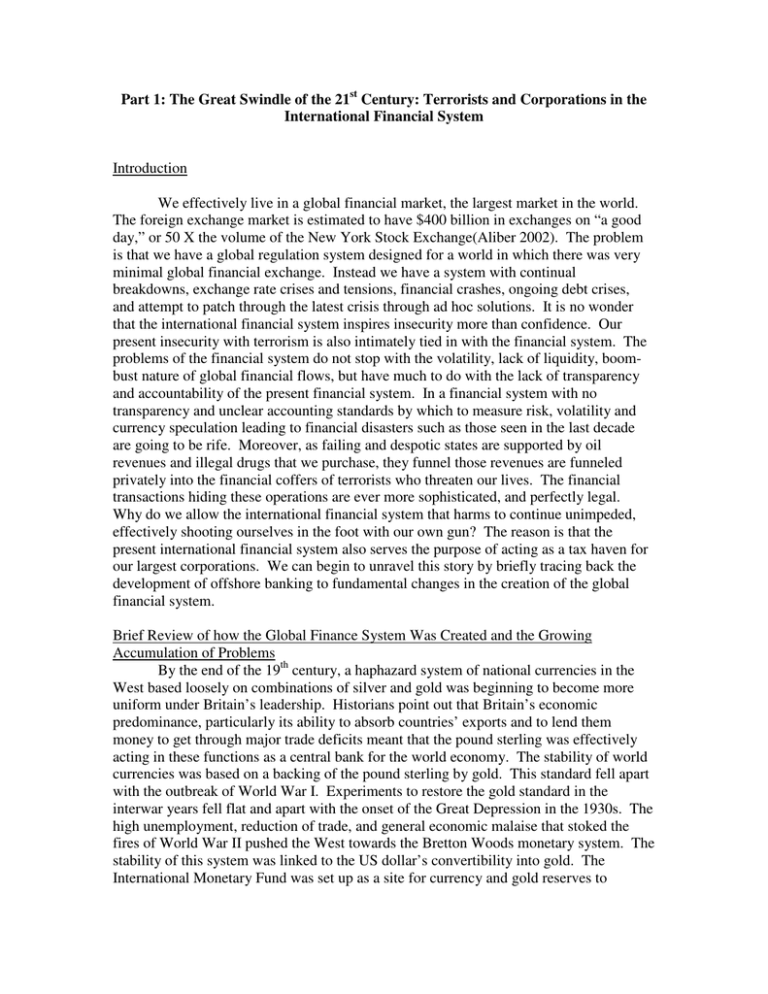
Part 1: The Great Swindle of the 21st Century: Terrorists and Corporations in the International Financial System Introduction We effectively live in a global financial market, the largest market in the world. The foreign exchange market is estimated to have $400 billion in exchanges on “a good day,” or 50 X the volume of the New York Stock Exchange(Aliber 2002). The problem is that we have a global regulation system designed for a world in which there was very minimal global financial exchange. Instead we have a system with continual breakdowns, exchange rate crises and tensions, financial crashes, ongoing debt crises, and attempt to patch through the latest crisis through ad hoc solutions. It is no wonder that the international financial system inspires insecurity more than confidence. Our present insecurity with terrorism is also intimately tied in with the financial system. The problems of the financial system do not stop with the volatility, lack of liquidity, boombust nature of global financial flows, but have much to do with the lack of transparency and accountability of the present financial system. In a financial system with no transparency and unclear accounting standards by which to measure risk, volatility and currency speculation leading to financial disasters such as those seen in the last decade are going to be rife. Moreover, as failing and despotic states are supported by oil revenues and illegal drugs that we purchase, they funnel those revenues are funneled privately into the financial coffers of terrorists who threaten our lives. The financial transactions hiding these operations are ever more sophisticated, and perfectly legal. Why do we allow the international financial system that harms to continue unimpeded, effectively shooting ourselves in the foot with our own gun? The reason is that the present international financial system also serves the purpose of acting as a tax haven for our largest corporations. We can begin to unravel this story by briefly tracing back the development of offshore banking to fundamental changes in the creation of the global financial system. Brief Review of how the Global Finance System Was Created and the Growing Accumulation of Problems By the end of the 19th century, a haphazard system of national currencies in the West based loosely on combinations of silver and gold was beginning to become more uniform under Britain’s leadership. Historians point out that Britain’s economic predominance, particularly its ability to absorb countries’ exports and to lend them money to get through major trade deficits meant that the pound sterling was effectively acting in these functions as a central bank for the world economy. The stability of world currencies was based on a backing of the pound sterling by gold. This standard fell apart with the outbreak of World War I. Experiments to restore the gold standard in the interwar years fell flat and apart with the onset of the Great Depression in the 1930s. The high unemployment, reduction of trade, and general economic malaise that stoked the fires of World War II pushed the West towards the Bretton Woods monetary system. The stability of this system was linked to the US dollar’s convertibility into gold. The International Monetary Fund was set up as a site for currency and gold reserves to preserve monetary stability. Currencies were allowed to move against one another in value within a band, however safeguard clauses for major changes were allowed in the even of “fundamental disequilibrium.” Such disequilibria were expected to be rare, as controls on capital movements were encouraged. The US effectively took up the position of Central Bank to the world. The US opened up its markets to Japan and Europe, running consistent trade deficits with them (accepting far more exports from abroad than the US exported), which led to a slow increase in international monetary liquidity as those economies (and their currencies) grew in value. It is interesting to see the ironies of history in this case where, in part, the success of this system helped to undermine it in the end. As these economies grew, and US trade deficits ballooned with first the Korean and then the Viet Nam Wars, European central banks became less willing to accept dollars as payments and their own currencies became more credible and so were allowed to float. They began demanding payments of gold for the trade deficits, which undermined further confidence in the US dollar, which was supposed to be based on gold backing. The European currencies became mechanisms for private currency speculation, and Eurocurrency (or Eurodollar) banks, set up for this purpose, sites for large movements of capital. The Eurodollar banks were designed with minimal regulation in order to facilitate the flow of dollars free from US domestic controls. The rising spectre of inflation and trade deficits led President Nixon to de-link the dollar from gold in 1971, leading to the demise of this brief period of coordinated fixed exchange rates. The new era of global monetary relations began. This new era included the explosive growth of global capital movements, both through multinational corporation operations and through speculation against now flexible exchange rates. The levels and frequency of flows of capital intensified after 1973, when newly wealth OPEC oil producers flooded the Eurocurrency and American financial houses with their savings. This led directly to the debt crisis of the 1980s after the US raised interest rates precipitously in its reckoning with the inflationary beast. With the decline of oil prices as new supplies came on line, among other factors, monetary stability seemed to reach a new phase of an entente cordiale, with various agreements between the US, European, and Japanese central banks to “manage” exchange rate values. The dollar continues to serve as the main currency for international transactions, and the US market as the key absorber of exports to help countries grow their economies. Capital funneled through US financial centers seemed to finally begin reaching outwards by the 1990s as “emerging markets,” namely the liberalization of developing countries’ investment restrictions, a wave of privatizations, and the creation of stock markets led to a brief surge of international capital. However, from the 1980s, various cracks have begun to show the fragility of the system. First, the debt crisis of the 1980s, while alleviated somewhat by lower interest rates now, retains a stranglehold on growth in much of the developing world. Countries find themselves attempting to pay off interest, rather than principal, from the go-go borrowing years of the 1970s. The IMF attempts to restrict government spending there and to reduce corruption, but countries are unwilling to put their economies into recession. The relief of some debt in 2005 has not really changed the fundamental nature of this problem. Second, the new currency euro threatens in the long-run the possibility of displacing the dollar as the central currency of the globe. If the euro catches on, then the ability/willingness of the US to accept trade deficits in order to be able to take the lead on global money, such as setting international interest rates and pressuring for exchange rate concessions, may also diminish. What a 2 currency system would like is not clear, however, during the interwar period, attempts to co-manage the monetary system between the UK, France, and the US failed miserably. With US spending going through the roof on war expenditures, it is only lower interest rates that have allowed for growth to continue. However, should oil prices continue to increase, or interest rates creep up, inflationary pressures a la the Viet Nam period ware likely to reappear. Third, a new set of pressures is emerging with the ballooning trade deficits between China and the EU and the US. Despite a measly 2.1% devaluation of the Chinese renminbi, there is little prospect that such deficits will decelerate. In fact, as more work moves to China, it is possible we will see a return of stagflation- high unemployment and high inflation, as oil prices work their way through the system. Fourth, the inherent instability of hot monetary flows is reflected in a series of financial crises that have worked their way through the system, including Chile in 1982; Mexico in 1994; Russia in 1998; East and Southeast Asia 1997-8; Brazil in 1999; Argentina in 2001. With the dot com stock exchange collapse in 2000, there can be no question about the ravages of speculation on the availability of capital for borrowing. These crises have raised serious questions about “hot” money, essentially run by currency speculators and large pension funds, who, if they decide to move it quickly, can create a stampede, collapsing local stock markets and exchange rates. When such crises occur in developing countries, the IMF generally acts as a gatekeeper for international private capital, forcing structural adjustment in exchange for emergency lending. In general, these austerity measures force short-term government contraction of budgets and the raising precipitously of exchange rates overnight. The results is that many domestic companies and banks go out of business, and unemployment skyrockets (Stiglitz 2003). The IMF’s austerity package often includes lifting subsidized prices on essential items such as food and opening the economy to trade liberalization, leading to a flood of imports that knock domestic business back even further. The poorest groups in society as well as the middle class are devastated by the sudden cutbacks in government spending and protection. Even more devastating is the fact that the IMF has no record of success in forcing long-term reforms of fiscal policy, so much of this suffering is to no end. The result has been a major drying up of investment funds available to developing countries and to growth sectors of the economy; the present run on real estate reflects not only low interest rates, but a perceived lack of alternatives. Real estate speculation may be fueling the economy, but as in East and Southeast Asia, when it becomes overly speculative, the non-productive nature of such investments becomes revealed when the bubble collapses. Investment in infrastructure, education, and companies builds capacity for greater production that has multiplying effects; investment in houses builds a one-time increase in places to live, or renovation of existing places to live. Basic Weaknesses of the Current Global Financial System In any financial system, savings are turned into investment/lending through financial intermediaries. Modern finance recognizes the time value of money. In the North, we count on banking regulation, supervision, and deposit insurance, as well as the counterparts in terms of securities investment. Our financial system is buttressed by legal enforcement of contracts and property rights. Our central bank carefully controls the amount of money to ensure that there is liquidity but minimal inflation in the system. We expect our central governments to audit banks in order to ensure sound lending practices, no discrimination, and adequate reserves. We threaten banks that launder money or otherwise abet illegal activities with criminal penalties, and have law enforcement dedicated to such investigations. Unfortunately, no such financial infrastructure exists on the global level. Investment always brings with it some volatility- that is in the nature of risk assessments and taking chances is vital to economic growth and development. However, an unproductive volatility happens with financial “contagion,” in which a herd of investment follows the lead of several key actors or news events. It was this kind of contagion that led directly to the domino financial crises of recent years, with jittery large investment fund managers creating self-fulfilling prophecies in creating runs on Asian and other stock and currency exchanges. In these cases, ordinary balancing market mechanisms such as arbitrage and derivatives and future contracts can actually worsen rather than ameliorate volatility. Recently, the dot com bust and scandals such as Enron and MCI have brought domestic accounting procedures and the necessary faith in the financial system into question, in part helping to fuel the real estate market. The problem is that this use of funds does not help companies seeking to grow and who would create employment, incomes, and jobs as they grow. The problems of volatility are compounded on the international level with global finance. The result is many developing countries, with quite weak domestic financial systems, suffer from an ongoing capital shortage. This forces developing country governments and companies to borrow at many times the domestic US interest rate, making development even harder. Ironically, this occurs at the same time as their own citizens put billions of dollars into overseas accounts because they have no confidence in their own banks. Most citizens of developing countries have almost no ability to borrow for a mortgage or a car, which stifles demand for these types of items. Moreover, when they do borrow, there is no legal entity to force them to pay or to allow them to declare bankruptcy. There is not even any agreement on basic international accounting standards, let alone mechanisms to ensure the accuracy of such statements on an international scale. As a result, we have an international situation of ongoing major external indebtedness, which serves the purposes of neither international financial lenders nor borrowers in the long-run. How Offshore Banks Aid Terrorists and Corporations The problems of hot money have led to a number of reform proposals for global finance. The Tobin tax is one proposal to tax currency exchange transfers in order to slow down those aimed towards speculation. By adding a slight % tax on each transaction, the overall number of transactions would likely decrease and become more deliberate. Anne Krueger of the IMF has also suggested allowing developing countries to declare bankruptcy, which would allow them to start with a clean slate, however might end their access to credit for a long time. A significantly greater level of global cooperation on taxation is deemed necessary by mainstream economic institutions such as the OECD, in order to avoid harmful competition for firms which leads to a continual race to the bottom in terms of reducing taxes (Hines 2001; OECD 1998). All of these proposals have fallen flat in the face of the strength of financial lobbies. Benjamin Cohen points out that much of the opposition to creating stronger regulation of international capital flows lies in the ideological bent of most economists guiding economic policy in Washington and to the stringent opposition of Wall Street financial houses who make money on the transactions of the current system(Cohen 2003). However, behind those lobbies is an even more serious threat to us, namely the use of offshore banks as tax havens. Companies use transfer pricing to avoid paying taxes in markets where they make money, creating phony losses, while they move the money to offshore tax havens, where it is reported as income. Similarly corrupt practices allow companies such as Enron to hide losses. In the wake of Sept. 11, 2001, serious questions were raised about the growing headquartering of companies or phony subsidiaries in places like the Cayman Islands. These headquarters are often just a mailbox or a legal document. No tracing of the financial flows of accounts through offshore banks is possible- secrecy is assured. Moreover, the use of multiple shell companies and subsidiaries, registered for a few hundred dollars that appear and disappear with the blink of an eye, makes even traceable transactions disappear in the dust. William Brittain-Catlin documents, “In any one year, BP (British Petroleum) may have up to a billion dollars’ income kept in pay as tax-deferred capital that can be reinvested across the company in further offshore-controlled ventures. If the game is played well, tax can be avoided pretty much indefinitely.” He goes on to cite some of the firms that are known to have had millions or billions of dollars offshore, including Apple Computer, MBNA, the credit card company, CSX freight company, General Motors, Ford, ExxonMobil, IBM, Wal-mart, GE, and Citigroup, which was able in 1999 to avoid “paying $399 million in US federal income tax” through the scheme. By the end of 2002, US companies had around $639 billion in offshore accounts (Brittain-Catlin 2005) Not only are companies able to hide much of their profits and avoid paying taxes, but so are dictators, terrorists, and narco-traffickers. Offshore banks are not just places for deposits, but also sources of mutual funds and other large investment instruments. In a recent revealing article, analysts suggest an apt metaphor for al-Qaeda and Islamic fundamentalist terrorism generally- the dune (Mishal 2005). Like a dune, alQaeda appears and disappears as new cells are inspired and become active, with no centralized apparatus, but only generally shared ideological and religious beliefs around the mission to attack the West. Terrorists generally are nowadays supra-national, able to use the internet and support and financial networks to purchase weapons and aid comrades in ways that cross borders (Cronin 2003). In this sense, we can see that alQaeda has become quite adept at using the finance and technology innovations of the West against itself. There is strong evidence that al-Qaeda has used not only the internet (in an information sense an equally viable strategy for decentralizing an proliferating sources) but also offshore finance to conduct its operations. It is well known that Bin Laden comes from a family involved in the construction business set up in Saudi Arabia. Like many other terrorist groups fueled by hatred of the corrupt and oppressive regimes that we support, whose ineffectiveness condemns much of the region to poverty, Bin Laden relied upon patrons made wealthy from these very regimes and their Western partners to fund his operations. In effect, the terrorist business makes money derived from oil revenues, that is, ultimately from us as oil consumers. Certainly demolishing offshore finance and attacking the miserable conditions of many in the Middle East will not complete erase the motivations of terrorists, which are centered around US foreign policy, however, such actions, in concert with policy changes to support democracy, human rights, and prosperity around the region would. A number of analysts note that the lack of opportunity to make a good life is a significant motivating factor behind terrorist actions (Steven 2004). Indeed, my argument is not against the well-documented fact that the majority of terrorists come from middle- and upper-class origins, but rather that the lack of opportunity for those middle-class members in their own countries to lead productive and distinguished lives in a positive sense fuels their turn to terrorism. Some analysts back up this point, suggesting that antipathy for the US is party based on policies and partly is misplaced frustration from extremely high population growth rates and a lack of opportunity (Rabasa 2004). The terrorists find recognition and comfort in the social networks and mission they come to embrace (Sageman 2004). Whether this argument is correct or not does not take away from the fact that we can not fight the battle against terrorism without a more centralized global financial system. Conclusion Mainstream analysts have cautiously put forward the idea of greater cooperation in global finance, including the development of international accounting standards and global pressure for sounder financial practices at the national level in developing countries and/or a modification in the approach to international lending (Bryant 2003; Haldane 2004; Hawkins 2001; Isard 2005; Stiglitz 2003). Much more decisive action than this is needed, action that breaks the taboo of state sovereignty, which holds up any breakthrough in investment (Seid 2002). The global market for credit is potentially vastly greater if a global accounting system can be established with clear standards and enforcement mechanisms. Developing countries would have no reason not to participate in such a system, as it would open up capital in vast amounts to their companies, citizens, and themselves. We would want an international bankruptcy system for all three entities, and this means a global information system is needed as part of the banking system. We would not really need to construct a full-fledged central banking system in order to make such a system work. Rather, the international accounting entity, perhaps built up through the Bank of International Settlements or the International Monetary Fund, or some combination. Important also would be great transparency throughout the system. Such transparency would create a system of self-enforcement, as countries or companies or citizens who cheated or had a bad credit history would have these facts available to certified lending institutions. More importantly, we need to close the loopholes that allow the underside of international finance to thrive. Under international law, the US can only pressure places such as the Cayman Islands to make such accounts transparent. Even where this has some success, dozens of other offshore locations can fill this role. Moreover, the US has no control over the sovereign decisions of another nation in regard to corporate disclosure or taxation. Some proposals have been made in the US Congress to push for corporate disclosure of overseas operations and offshore accounts, however the bottom line is that there is no enforcement mechanism. Such enforcement can only come from the creation of a global taxation entity. Creation of such an entity would help us to break through the impasse of state sovereignty, in the sense that it would create incentives for cooperation in order to be eligible for funding. A global financial entity could use the tax revenues to provide for collective international public goods, such as environmental and health crises; anti-cyclical policies (world or regional recessions); and investment in human capital and population control (Ocampo 2003). Regulating global finance can not just stop at offshore centers, but must also consider other stores of value, such as diamonds and gold. Terrorist networks have moved into these more mobile stores of value, reducing their vulnerability to asset seizures. For those who still doubt the importance of global regulation, one need only remind them of the connection between diamonds, Africa’s recent brutal civil wars, and al-Qaeda (Farah 2004). In this sense, we can not separate out international finance from global production of goods and services, to which we now turn. We examine what a global financial entity might look like in the final chapter. Aliber, Robert Z. 2002. The New International Money Game. 6th ed. NY: Palgrave. Brittain-Catlin. 2005. Offshore: The Dark Side of the Global Economy. NY: Farrar, Straus and Giroux. Bryant, Ralph C. 2003. Turbulent Waters: Cross-Border Finance and International Governance. Washington: Brookings Institution. Cohen, Benjamin J. 2003. Capital Controls: The Neglected Option. In International Financial Governance under Stress: Global Structures versus National Imperatives, edited by G. R. D. U. a. X. Zhang. NY: Cambridge U Press. Cronin, Audrey Kurth. 2003. Behind the Curve: Globalization and International Terrorism. International Security 27 (3):30-58. Farah, Douglas. 2004. Blood From Stones: The Secret Financial Network of Terror. NY: Broadway. Haldane, Andrew G, ed. 2004. Fixing Financial Crises in the Twenty-First Century. NY: Routledge. Hawkins, John and Philip Turner. 2001. International Financial Reform: Regulatory and Other Issues. In International Financial Contagion, edited by S. C. a. K. J. Forbes. Boston: Kluwer. Hines, James R, ed. 2001. International Taxation and Multinational Activity. Chicago: U of Chicago Press. Isard, Peter. 2005. Globalization and the International Financial System: What's Wrong and What Can Be Done. NY: Cambridge U Press. Mishal, Shaul and Maoz Rosenthal. 2005. Al-Qaeda as a Dune Organization: Toward a Typology of Islamic Terrorist Organizations. Studies in Conflict and Terrorism 28:275-293. Ocampo, Jose Antonio. 2003. International Asymmetries and the Design of the International Financial System. In Critical Issues in International Financial Reform, edited by A. B. a. G. Indart. New Brunswick, NJ: Transaction. OECD. 1998. Harmful Tax Competition: An Emerging Global Issue. Paris: OECD. Rabasa, Angel M, et al. 2004. The Muslim World After 9/11. Santa Monica: Rand Corporation. Sageman, Marc. 2004. Understanding Terror Networks. Philadelphia: U of Pennsylvania Press. Seid, Sherif H. 2002. Global Regulation of Foreign Direct Investment. Burlington, VT. Steven, Graeme C. S., and Rohan Gunaratna. 2004. Counterterrorism. Denver: ABC Clio. Stiglitz, Joseph. 2003. Globalization and Its Discontents. NY: WW Norton.
